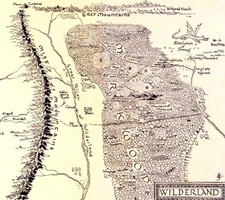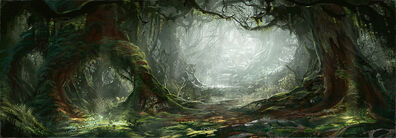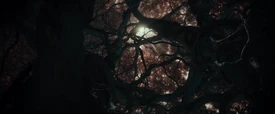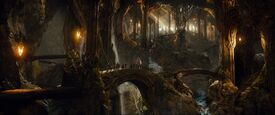The Hobbit There and Back Again Mirkwood
Mirkwood, initially and later on once again known as the Greenwood, was the greatest forest of Middle-earth, located in the eastern region of Rhovanion between the Grey Mountains and Gondor.
It was also known as Greenwood the Great, Eryn Galen, or Taur-e-Ndaedelos, and was after re-named Eryn Lasgalen, the Wood of Greenleaves.
Contents
- 1 Description
- ii History
- ii.ane Quest of Erebor
- three Portrayal in adaptations
- 3.1 Peter Jackson'southward The Hobbit moving-picture show trilogy
- 3.2 Video games
- four Notes
- 5 Translations
- vi References
Description

Map of Mirkwood in Wilderland, from The Hobbit.
Mirkwood was a dumbo and heavy woodland that fabricated up much of the eastern portion of Rhovanion or Wilderland, that maintained its borders and relative shape for many ages. Its natural land features included (in the northern part of the woods) the Mountains of Mirkwood, a sizable river referred to in Tolkien's map as the Woods River, that ran from the Greyness Mountains down to Long Lake, and a smaller river that ran from the Mountains of Mirkwood to bring together with the Forest River westward of the Elven-king'due south Halls.[1] This smaller river was enchanted (or polluted) to such an extent that it caused sleep and forgetfulness to anyone who savage into it.[2]
Mirkwood's climate was relatively mild.[three] Except for means through the thickets of the woods, there were very few common routes through Mirkwood save for the Onetime Woods Route and the Forest Path. Mirkwood was approximately 600 miles long from due north to southward, and 250 miles across at its width. During the events of The Hobbit information technology was home to giant spiders, and the kingdom of Male monarch Thranduil and his Wood-elves[4]; the Woodmen of Mirkwood as well inhabited a small part of the forest.
History

The forest that would become Mirkwood dates back to the earliest days of Centre-earth. The Elves passed through it on their Great Journey from Cuiviénen into the Far West - it was where they made their first long stop before continuing onward. Thereafter, Greenwood the Dandy was the habitation of the Wood-elves (the Nandor, Elves descending from the wandering Teleri Elf Lenwë) for many thousands of years. The Sindarin Elf Oropher, who was the gramps of Legolas, established the Woodland Realm proper, and it become the main settlement of the Elves from the Second Historic period onward. It was around this time that Men, possibly ancestors of the Northmen, began making permanent settlements in and around the forest. When Oropher was killed in the War of the Last Alliance, the kingship passed to his son Thranduil.

Light peering through the thick trees of Mirkwood
Mirkwood had been chosen Greenwood the Great until around the year TA 1050, when the shadow of the Dark Lord Sauron fell upon it, and men began to phone call it Mirkwood, or Taur-nu-Fuin and Taur-e-Ndaedelos in the Sindarin tongue. From and so on, Mirkwood became a haunted place inhabited past many dark and fell things. Sauron, or the 'Necromancer' as he disguised himself, established himself at the hill-fortress of Dol Guldur, an old Elven fortress in the forest'south southern region, and drove Thranduil and his people always north
During the Watchful Peace Dol Guldur was abandoned for a fourth dimension and the Elves had respite, but later four hundred years Sauron returned to Dol Guldur and pressured the Elves once again. Past the end of the Third Age they were a diminished and wary people, who had entrenched themselves due north of the Mountains of Mirkwood. The Quondam Forest Route (also called the Dwarf Road or Men-i-Naugrim) crossed the forest e to west, only because it was so close to Dol Guldur the road was likewise unsafe to travel. The Elves then made a path farther to the north, the Forest Route, starting at the Woods Gate and catastrophe in the marshes west of the Long Lake of Lake-boondocks.
Quest of Erebor

Entrance to the Elvenking'due south Halls
Bilbo Baggins, along with Thorin Oakenshield and his band of Dwarves, ventured into Mirkwood during their quest to regain the Lonely Mount from the dragon Smaug, taking the Elven path. There, the Dwarf Bombur fell into the Enchanted river (causing him to autumn comatose). Later, they came across many groovy Giant Spiders likewise known every bit the Spawn of Ungoliant. Shortly afterwards the Dwarves' escape, they were captured by the Elves. After or during these events the White Council attacked Dol Guldur, and Sauron fled to Mordor, his influence in Mirkwood macerated for a while, but Dol Guldur was soon re-occupied by three Nazgûl. Years later on Gollum, after his release from Mordor, was captured by Aragorn and brought as prisoner to Thranduil'southward Halls. He escaped during an Orc raid, and fled southwest to Moria.
Later on Sauron was vanquished at the conclusion of the 3rd Age, the darkness was lifted from Mirkwood, Dol Guldur was utterly destroyed by Galadriel and Thranduil gave the forest the proper name Eryn Lasgalen (Sindarin for wood of green leaves), similar to its quondam name Eryn Galen, or Greenwood. The southernmost portion of the woods became known as Due east Lórien for a time, while the central portion was given to the Woodmen.
Portrayal in adaptations
Peter Jackson'due south The Hobbit film trilogy
Mirkwood is featured in Peter Jackson'due south The Hobbit: The Pathos of Smaug and The Hobbit: The Boxing of the Five Armies.
During Thorin Oakenshield's and Bilbo Baggins' journey, they and their company wished to enter Mirkwood as a shortcut to the Lone Mountain. At the edge of the wood at the Elven Gate, Gandalf was tasked by Galadriel to investigate the High Fells of Rhudaur. Before he departed, Gandalf gave the Company one more slice of communication: The beginning, he told them to be wary in the woods because the air was befouled with dark magic that would cause hallucinations. Next, he warned them of a stream that had been enchanted with a night spell and to cross by the bridge only. He final warned them to stay on the Elf-path, for if they strayed away from information technology, they would never find it again.
The visitor traveled through the forest and stayed on the path equally Gandalf had told them. However, the forest soon began twisting their minds, and causing Thorin and Company to either hallucinate or feel weakened. They traveled for days until they come beyond the enchanted stream Gandalf told them of but plant that the span had been destroyed. Kíli had establish a way to cross by using the vines to become to the other side. Thorin sent Bilbo across first, just equally the Hobbit crossed, Bilbo began feeling the river's enchantment pulling him. He was able to quickly complete his passage, but fearing for the others, yelled for them to terminate, only to find that the company was already crossing. Thorin reached the other side before the others. During this fourth dimension, Thorin and Bilbo spotted a White Stag approaching them. Though Bilbo was amazed past the creature, Thorin immediately fired at the creature, simply the stag disappeared. Meanwhile, Bombur had succumbed to the spells and had fallen asleep and into the water, forcing the other Dwarves to fashion a stretcher and carry him.
Thorin began succumbing to the polluted air of the forest and hurriedly led his company off the path. During the rest of their time in the nighttime woods, Nori had lost trace of the path the visitor had went on. Bilbo managed to snap out of the dark spell and told his companions they were lost but the Dwarves began to feel the foul air of the woods. They began quarreling and even fighting among themselves. Equally they argued, Bilbo took notice of extensive webbing around them. Bilbo so took information technology upon himself to detect out where he and the company were at. When the company was distracted, Bilbo climbed up a tree while Thorin heard whispers Bilbo had warned him about earlier and told the company they were being watched. Meanwhile, when Bilbo reached the summit, he saw they were almost to the Solitary Mount. At the same time, Bilbo's Dwarven friends were captured past gigantic spiders. When he shouted to the Dwarves he knew they were in the correct management, Bilbo heard no response from them and saw something coming. Soon, Bilbo suffered the aforementioned fate as his companions and was captured past the other spiders.
Withal, Bilbo managed to costless himself from his spider cocoon. Slipping he ring he'd found onto his finger, he became invisible to the monsters and constitute he could understand them as they spoke. He managed to impale one of his captors with Sting and cut his companions loose when he saw one of the Spiders threatening to eat Bombur. While the Dwarves escaped their captors, Bilbo was separated from the grouping, where he attacked a infant spider due to the Ring's influence. Soon, the Hobbit heard his company in distress. Legolas of the Woodland Realm cornered Thorin Oakenshield and Company, along with Tauriel and other Elves. After defeating the spiders, the company was captured for "snooping around" in the kingdom.
Thranduil had Thorin and his visitor locked up in the Rex'southward dungeons with the exception of Bilbo who managed to evade capture all the same again and had been trailing the Elves. Thranduil attempted to attain an accord with Thorin but the Dwarf refused considering he would not surrender Bilbo Baggins. Shortly, Bilbo freed Thorin and his companions from their cells and the company escaped in barrels spring for Lake-boondocks.

The Woodland Realm
Video games
Mirkwood is depicted in multiple video games, such as The Lord of the Rings: War of the Ring, The Hobbit (2003 video game), The Lord of the Rings: The Battle for Heart-earth, The Lord of the Rings: The Battle for Heart-earth II, The Lord of the Rings Online, and The Lord of the Rings: War in the North .
Notes
- Despite beingness called Mirkwood e'er since Tertiary Historic period 1050, Mirkwood is referred to past Radagast and Gandalf in The Hobbit: An Unexpected Journeying as the Greenwood, with Gandalf mentioning to the White Council that the woodsmen in that location only recently started calling it Mirkwood considering of the sickness that had fallen over it.
- Mirkwood as well appears in The Fall of Arthur , every bit well as in one of Eriol's poems as Myrcwudu (Old English: 'Mirkwood'), which was an ancient Germanic legendary proper noun for a great dark boundary-forest constitute in diverse different applications. Ælfwine's reference was to near the Eastern Alps, while the reference in the Fall of Arthur was somewhere eastward of the Rhine.
- In Eye-earth, Mirkwood refers to 2 forests, i in the Starting time Age; Dorthonion, later called Taur-nu-Fuin of Beleriand, and the other in the Third Historic period west of the Lonely Mountain in Rhovanion.
Translations
| Strange Linguistic communication | Translated name |
| Amharic | ሚርክዎኦድ |
| Arabic | ميركوود |
| Armenian | Միրկւոոդ |
| Basque | Oihan Beltza (Mirkwood) Oihan Berde Handiak (Greenwood the Dandy) |
| Byelorussian Cyrillic | Ліхалессе |
| Bengali | মির্ক্wওওদ |
| Bosnian | Mrka Šuma |
| Bulgarian Cyrillic | Мраколес (Mirkwood) Зеленогор Велики (Greenwood the Great) |
| Catalan | Bosc Llobregós (Mirkwood) Gran Bosc Verd (Greenwood the Great) |
| Chinese (Hong Kong) | 幽暗密林 (Mirkwood) 巨綠森 (Greenwood the Smashing) |
| Czech | Temný hvozd (Mirkwood) Velký zelený hvozd (Greenwood the Slap-up) |
| Danish | Dunkelskov |
| Dutch | Demsterwold (Mirkwood) / Grote Groenewoud (Greenwood the Great) |
| Estonian | Sünklaas (Mirkwood) Suur Rohelaas (Greenwood the Great) |
| Finnish | Synkmetsä (Mirkwood) Suuri vihermetsä (Greenwood the Great) |
| French | Forêt Noire/Forêt de Grand'Peur (Mirkwood) Vertbois le Thou (Greenwood the Great) |
| Galician | Bosque Escuro (Mirkwood) Gran Bosque Verde (Greenwood the Dandy) |
| German | Düsterwald (Mirkwood) Große Grünwald (Greenwood the Groovy) |
| Georgian | ბნელტევრი (Mirkwood) დიდებული მწვანეტევრი (Greenwood the Great) |
| Greek | Μίρκγουντ |
| Gujarati | મિર્ક્વૉદ |
| Hebrew | מירקווד/יעראופל |
| Hindi | मिर्क्वोओद |
| Hungarian | Bakacsinerdő |
| Italian | Bosco Atro/Bosco tetro (Mirkwood) Boscoverde il Grande (Greenwood the Great) |
| Japanese | 闇の森 (Mirkwood) 緑森大森林 (Greenwood the Nifty) |
| Kannada | ಮಿರ್ಕ್ವುಡ್ |
| Kazakh | Міркуоод (Cyrillic) Mirkwood (Latin) |
| Kyrgyz Cyrillic | Миркwоод |
| Macedonian Cyrillic | Миркwоод |
| Marathi | मिर्क्वोओद |
| Mongolian Cyrillic | Миркүоод |
| Nepalese | मिर्क्वोओद |
| Norwegian | Mørkeskogen/Myrkskog (Mirkwood) Shop Grønnskogen (Greenwood the Swell) |
| Pashto | میرکووود ? |
| Farsi | میرکوود |
| Polish | Mroczna Puszcza (Mirkwood) Wielkim Zielonym Lasem (Greenwood the Not bad) |
| Portuguese | Floresta das Trevas (Brazil) Floresta Tenebrosa (Portugal) |
| Romanian | Codrul Întunecat |
| Russian | Лихолесье (Mirkwood) Великим Зеленолесьем (Greenwood the Neat) |
| Sanskrit | मिर्क्वोओद् |
| Serbian | Мирквоод (Cyrillic) Divim Mrkoj (Latin) |
| Slovak | Temnohvozd |
| Slovenian | Mrkolesje |
| Spanish (Spain and Latin America) | Bosque Negro (Mirkwood) Gran Bosque Verde (Greenwood the Keen) |
| Swedish | Mörkmården Mörkveden |
| Tamil | மிர்க்௰ஓத் ? |
| Thai | เมิร์ควู้ด (Mirkwood) ป่าใหญ่กรีนวู้ด (Greenwood the Great) |
| Turkish | Kuyutorman (Mirkwood) Büyük Yeşil Orman (Greenwood the Great) |
| Ukrainian Cyrillic | Мірквуда (Mirkwood) Ерін Ласгален (Eryn Lasgalen) |
| Urdu | مرکوود ? |
| Uzbek | Миркwоод (Cyrillic) Mirkwood (Latin) |
| Yiddish | מירקוואָאָד |
| | |
|---|---|
| | Amon Ereb • Brethil • Dor-lómin • Estolad • Ladros • Rhûn • Harad • Eriador |
| | Arnor • Dunland • Gondor • Harad • Númenor • Rhûn • Umbar |
| | Arnor (later split into Arthedain, Cardolan, and Rhudaur) • Rohan • Urban center of Dale (later became a Kingdom) • Dunland • Lake-town (later on part of the Kingdom of Dale) • Gondor • Harad • Khand • Kingdom of Rhovanion • Rhûn • Umbar • Vales of Anduin |
| | Kingdom of Dale • Harad • Núrn • Reunited Kingdom of Gondor and Arnor • Rohan • Rhûn • Khand • Eriador • Rhovanion • Vales of Anduin |
| | |
|---|---|
| | |
| | |
| | |
| | |
| | |
References
- ↑ The Atlas of Middle-earth, The Third Age, "Introduction"
- ↑ The Hobbit
- ↑ The Atlas of Middle-world, Thematic Maps, "Landforms"
- ↑ The Atlas of Eye-earth, Regional Maps, "Eriador"
carswellquichishipt71.blogspot.com
Source: https://lotr.fandom.com/wiki/Mirkwood


0 Response to "The Hobbit There and Back Again Mirkwood"
Post a Comment